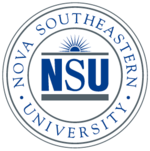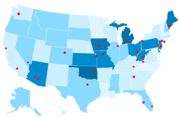- Nova Southeastern University College of Osteopathic Medicine
-
Nova Southeastern University College of Osteopathic Medicine 
Established 1979 Type Private Dean Anthony J. Silvagni, D.O., Pharm. D., M.Sc., FACOFP Location Davie, Florida, USA Website medicine.nova.edu The Nova Southeastern University College of Osteopathic Medicine is the graduate medical school of Nova Southeastern University. It is located in Fort Lauderdale, Florida.
The College of Osteopathic Medicine is part of the Health Professions Division of the university. The Health Professions Division, with a student body of more than 2,000, is home to Nova Southeastern University College of Osteopathic Medicine, the first College of Osteopathic Medicine in the southeastern U.S., granting the Doctor of Osteopathic Medicine (D.O.) degree. EMS Education and Training, Master of Science in Medical Informatics, and Master of Public Health are also offered.
Contents
History
The Southeastern College of Osteopathic Medicine (SECOM) was established in 1979 in North Miami Beach, Florida by Morton Terry, D.O. Following SECOM's success, the College of Pharmacy was added in 1986, followed by the College of Optometry in 1988, creating the Southeastern University of Health Sciences. In 1994, Southeastern University merged with Nova University, creating Nova-Southeastern University. The College of Osteopathic Medicine moved from North Miami Beach, Florida to Davie, Florida, in 1996. A fourth health professions college - the College of Dental medicine - was added in 1997.
Academics
The College of Osteopathic Medicine offers Doctor of Osteopathic Medicine (D.O.), Master of Public Health (M.P.H.), and Master of Biomedical Informatics (M.S.) degrees. Students enrolled in the Doctor of Osteopathic Medicine program can also apply for admission into the combined D.O./M.P.H. program. In addition, and in conjunction with the Nova Southeastern University College of Dental Medicine, the College of Osteopathic Medicine offers a combined D.O./D.M.D. degree. Graduates of this six-year program will be qualified for licensure in dentistry and for postgraduate residencies required for medical licensure.
Societies
First year medical students are placed into one of 10 societies upon matriculation to the College of Osteopathic Medicine. At the white coat ceremony prior to beginning of the first medical school year, students are officially inducted or "pinned" into their society when they receive their society pin from upperclassmen in their society. Each society is overseen by a faculty member, who serves as an advisor and mentor to students in their society during their medical school years. Each year, students compete in a variety of social and academic events to earn points for their society. At the end of each year, the society with the most overall points receives the College of Medicine Cup, or COM-Cup.
The 10 societies of the Nova Southeastern University are named after physicians and educators that have been influential members of the medical community both as Osteopathic physicians and leaders at either SECOM or NSUCOM. The names of each society are shown below:
- Anderson Society
- Burns Society
- Klein Society
- Lippman Society
- Silvagni Society
- Silverman Society
- Still Society
- Terry Society
- Turner Society
- Zafonte Society
Curriculum
Year 1: Basic Sciences
- Biochemistry
- Gross Anatomy
- Neuroanatomy
- Histology
- Physiology
- Microbiology
- Clinical Practicum
- Osteopathic Principles & Practice I & II
- Principles of Radiology
- Public Health & Epidemiology
- Ethnocultural Medicine
- Basic Life Support
- Interdisciplinary Generalist Curriculum (IGC) Preceptorship I & II
- Medical Spanish
Year 2: Systems-Based Learning
- Principles of Pathology
- Principles of Pharmacology
- Principles of Clinical Medicine
- Hematopoietic & Lymphoreticular System
- Respiratory System
- Cardiovascular System
- Gastrointestinal System
- Endocrine System
- Women's Health
- Integumentary System
- Renal/Urinary System
- Musculoskeletal System
- Nervous System
- Pediatrics System
- Psychiatry & Behavioral Medicine
- Osteopathic Principles & Practice III & IV
- Medical Jurisprudence
- Medical Ethics
- HIV Seminar
- End-of-Life Seminar
- Rural Medicine
- Advanced Cardiac Life Support
- Pediatric Advanced Life Support
- Interdisciplinary Generalist Curriculum (IGC) Preceptorship III & IV
- Clinical Foundations
- Board Review
Year 3: Core Clinical Rotations
- Family Medicine (2 months)
- Geriatrics (1 month)
- Pediatrics (2 months)
- Internal Medicine (3 months)
- Surgery (2 months)
- Obstetrics and Gynecology (1 month)
- Psychiatry (1 month)
Year 4: Core Clinical and Elective Rotations
- Emergency Medicine (1 month)
- Rural/Underserved rotation (2 months)
- Rural selective (1 month)
- Electives (5 months)
Clinical training sites
During years 3 and 4, students leave NSU-COM's Davie campus to begin clinical rotations. Major affiliated training hospitals include:
- Broward General Medical Center (Fort Lauderdale, Florida)
- Bethesda Memorial Hospital (Boynton Beach, Florida)
- Memorial Regional Hospital (Hollywood, Florida)
- Mount Sinai Medical Center (Miami Beach, Florida)
- Miami Children's Hospital (Miami, Florida)
- South Florida State Hospital (Pembroke Pines, Florida)
- Palmetto General Hospital (Hialeah, Florida)
- Columbia Hospital (West Palm Beach, Florida)
- Largo Medical Center (Largo, Florida)
- Florida Hospital East Orlando (Orlando, Florida)
- Southampton Hospital (Southampton, NY)
- Southeast Alabama Medical Center (Dothan, AL)
Post-graduate placement
Although NSU-COM has traditionally produced many family medicine physicians, graduates go on to pursue careers in all specialties of medicine. NSU-COM maintains affiliated residency programs in family medicine, internal medicine, emergency medicine, preventative medicine, pediatrics, general surgery, orthopedic surgery, anesthesiology, and dermatology. Fellowship programs are offered in sports medicine, geriatrics, rheumatology, cardiology, forensic pathology, and gynecological oncology.
Notable alumni
- Dr. Will Kirby, D.O., FAOCD ('00) - clinical and cosmetic dermatologist; leading authority on laser tattoo removal, winner of CBS's Big Brother, has appeared on The Young & the Restless, and star of Dr. 90210.
- Tyler Cymet, D.O. (88)-Professor of Internal Medicine at the Johns Hopkins School of Medicine, described a new genetic syndrome called Erondu-Cymet Syndrome.
External links
- Nova Southeastern University College of Osteopathic Medicine
- American Association of Colleges of Osteopathic Medicine
Nova Southeastern University Based in Davie, FloridaColleges & schools Farquhar College of Arts & Sciences · Shepard Broad Law Center · H. Wayne Huizenga School of Business & Entrepreneurship
Oceanographic Center · Center for Psychological Studies · Graduate School of Computer & Information Sciences
Fischler School of Education · Graduate School of Humanities and Social Sciences
Health professions division College of Dental Medicine · College of Osteopathic Medicine · College of Pharmacy · College of Optometry · College of Medical Sciences · College of Allied Health and NursingCampus Athletics Miscellaneous Osteopathic medical schools in the United States Northeast Lake Erie COM Pennsylvania · New England COM · New York COM · Philadelphia COM · Touro NYC · UMDNJ-SOMSoutheast Lake Erie COM Bradenton · Lincoln Memorial · Nova Southeastern · Philadelphia COM Georgia · Pikeville KYCOM · Virginia COM · West Virginia SOM · William Carey UniversityCentral West Categories:- Nova Southeastern University
- Schools of medicine in Florida
- Osteopathic medical schools
- Educational institutions established in 1979
Wikimedia Foundation. 2010.

